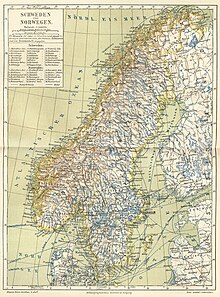Scandinavian Peninsula
Arctic Sea, Atlantic Ocean | |
| Area | 750,000 km2 (290,000 sq mi) |
|---|---|
| Highest elevation | 2,469 m (8100 ft) |
| Highest point | Galdhøpiggen |
| Administration | |
| Mainland | |
| Mainland | |
| Parts of Lapland | |
| Part of a series on |
| Scandinavia |
|---|
 |
The Scandinavian Peninsula[1] is located in Northern Europe, and roughly comprises the mainlands of Sweden, Norway and the northwestern area of Finland.
The name of the
The Scandinavian Peninsula is the largest of the peninsulas of
Geography

The largest peninsula in Europe, the Scandinavian Peninsula is approximately 1,850 kilometres (1,150 mi) long with a width varying approximately from 370 to 805 km (230 to 500 mi). The
Its highest elevation was
About one quarter of the Scandinavian Peninsula lies north of the
The climate across Scandinavia varies from tundra (Köppen: ET) and subarctic (Dfc) in the north, with cool marine west coast climate (Cfc) in northwestern coastal areas reaching just north of Lofoten, to humid continental (Dfb) in the central portion and marine west coast (Cfb) in the south and southwest.[6] The region is rich in timber, iron and copper with the best farmland in southern Sweden. Large petroleum and natural-gas deposits have been found off Norway's coast in the North Sea and the Atlantic Ocean.
Much of the population of the Scandinavian Peninsula is naturally concentrated in its southern part, which is also its
Geology
The Scandinavian Peninsula occupies part of the Baltic Shield, a stable and large crust segment formed of very old, crystalline metamorphic rocks. Most of the soil covering this substrate was scraped by glaciers during the Ice Ages of antiquity, especially in northern Scandinavia, where the Baltic Shield is closest to the surface of the land.[citation needed] As a consequence of this scouring, the elevation of the land and the cool-to-cold climate, a relatively small percentage of its land is arable.[7]
The
Although the Baltic Shield is mostly geologically stable and hence resistant to the influences of other neighbouring tectonic formations, the weight of nearly four kilometres of ice during the Ice Ages caused all of the Scandinavian terrain to sink. When the ice sheet disappeared, the shield rose again, a tendency that continues to this day at a rate of about one metre per century.[8] Conversely, the southern part has tended to sink to compensate, causing flooding of the Low Countries and Denmark.
The crystalline substrate of the land and absence of soil in many places have exposed mineral deposits of metal
People
The first recorded human presence in the southern area of the peninsula and Denmark dates from 12,000 years ago.[9] As the ice sheets from the glaciation retreated, the climate allowed a tundra biome that attracted reindeer hunters. The climate warmed up gradually, favouring the growth of evergreen trees first and then deciduous forest which brought animals like aurochs. Groups of hunter-fisher-gatherers started to inhabit the area from the Mesolithic (8200 BC), up to the advent of agriculture in the Neolithic (3200 BC).
The northern and central part of the peninsula is partially inhabited by the
Political development

Although the Nordic countries look back on more than 1,000 years of history as distinct political entities, the international boundaries came late and emerged gradually. It was not until the middle of the 17th century that Sweden had a secure outlet on the Kattegat and control of the south Baltic coast. The Swedish and Norwegian boundaries were finally agreed and marked out in 1751. The Finnish-Norwegian border on the peninsula was established after extensive negotiation in 1809, and the common Norwegian-Russian districts were not partitioned until 1826. Even then the borders were still fluid, with Finland gaining access to the Barents Sea in 1920, but ceding this territory to the Soviet Union in 1944.[11]
Denmark, Sweden and the
The
Sweden remained a
In 1945, Norway, Denmark and Iceland were founding members of the
In 1949, Norway, Denmark and Iceland became founding members of the North Atlantic Treaty Organisation for their defence against East Germany, the Soviet Union and all other potential invaders, and these three countries remain members as of 2021[update].[12]
Sweden and Finland joined the European Union in 1995. Norway, however, remains outside the Union.
See also
References
- ^ (Swedish: Skandinaviska halvön; Norwegian: Den skandinaviske halvøy (Bokmål) or Den skandinaviske halvøya (Nynorsk); Finnish: Skandinavian niemimaa)
- ISBN 0-521-47299-7. p. XXII. "The name Scandinavia was used by classical authors in the first centuries of the Christian era to identify Skåne and the mainland further north which they believed to be an island."
- ^ Olwig, Kenneth R. "Introduction: The Nature of Cultural Heritage, and the Culture of Natural Heritage—Northern Perspectives on a Contested Patrimony". International Journal of Heritage Studies, Vol. 11, No. 1, March 2005, p. 3: The very name 'Scandinavia' is of cultural origin, since it derives from the Scanians or Scandians (the Latinized spelling of "Skåninger"), a people who long ago lent their name to all of Scandinavia, perhaps because they lived centrally, at the southern tip of the peninsula."
- ^ Østergård, Uffe (1997). "The Geopolitics of Nordic Identity – From Composite States to Nation States". The Cultural Construction of Norden. Øystein Sørensen and Bo Stråth (eds.), Oslo: Scandinavian University Press 1997, 25–71.
- ^ "Norwegian Summit Elevation Debate". 6 March 2020. Archived from the original on 22 July 2021. Retrieved 22 July 2021.
- ^ "Glossary of American climate terminology in terms of Köppens classification". Archived from the original on 15 January 2016. Retrieved 28 April 2010.
- ISBN 0-534-46600-1
- ^ ISBN 0-89862-272-7
- ISBN 0-521-56821-8
- ISBN 0-8166-1738-4.
- ^ Sømme, Axel, ed. (1961). The Geography of Norden. Oslo: Den Norske nasjonalkommittee for geographi.
- ^ NATO. "Member countries". NATO. Archived from the original on 13 April 2021. Retrieved 14 April 2021.
